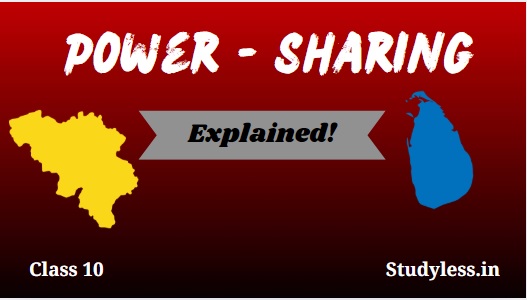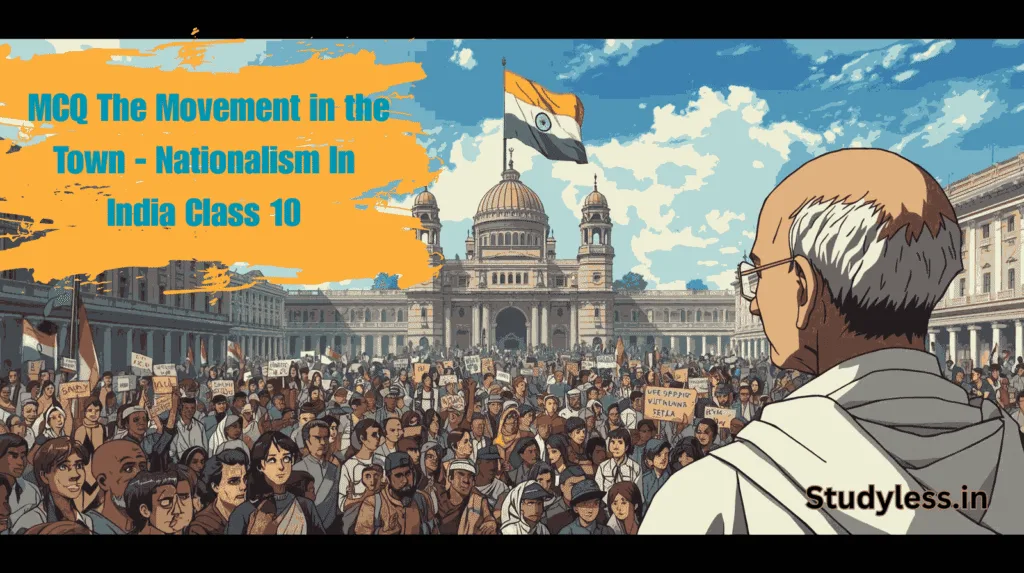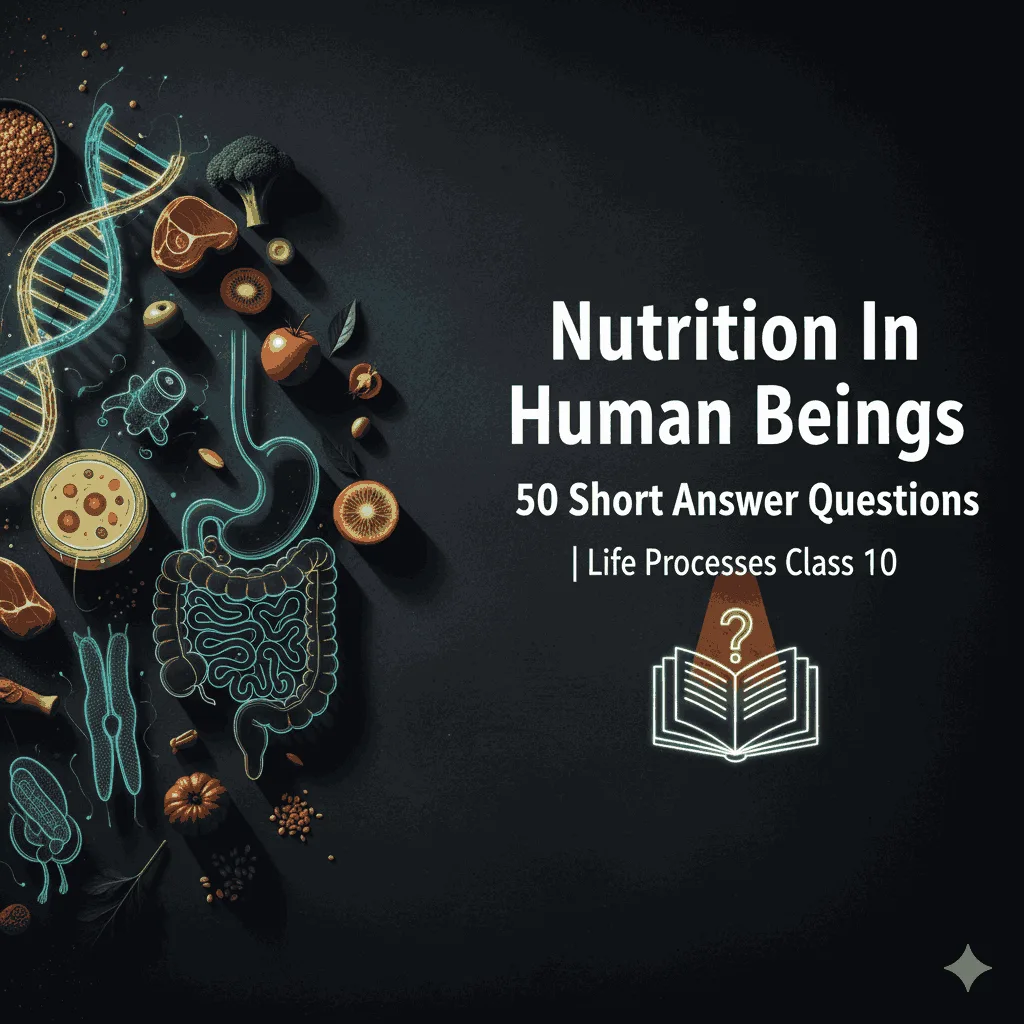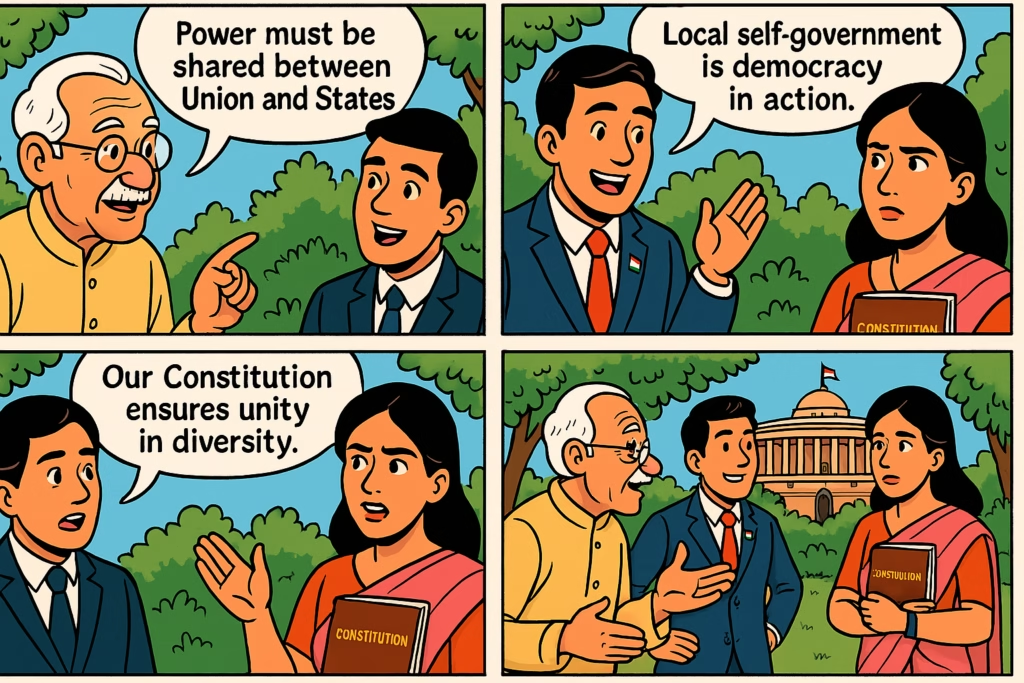
“In the Heart of Democracy: How India’s 1.4 Billion Voices Share Power – From Villages to Metropolises! 🌍
Imagine a nation where 3 million elected leaders – more than the population of Jamaica – govern not from distant capitals, but from your neighborhood’s dusty lanes and bustling city corners. Welcome to India’s grand experiment with power-sharing, where democracy isn’t just a system, but a living, breathing revolution!
From the fiery debates over linguistic states that redefined maps to the silent rise of women sarpanches transforming villages, this chapter unveils how India’s federalism dances between unity and diversity. Discover how the 73rd and 74th Constitutional Amendments turned grassroots governance into a force that builds toilets, schools, and bridges – literally and metaphorically.
But beware: Behind the triumph of Panchayati Raj and municipal corporations lurk battles for resources, political tug-of-wars, and villages fighting to reclaim their voice. Will India’s three-tier democracy survive its own contradictions?
Dive into a saga of:
- 🗝️ Constitutional Genius: How 1992 rewrote the rules of local power.
- 🌾 Rural Revolutions: Gram Sabhas deciding budgets, women sarpanches breaking barriers.
- 🏙️ Urban Warriors: Mayors vs. garbage mountains, traffic chaos, and funding droughts.
- ⚡ Women’s Rise: From 33% reservations to leading districts – the unsung heroines of democracy.
‘Democracy dies in darkness,’ they say. But in India, it thrives in the sunlight of villages and the neon glow of cities. Ready to decode the world’s largest democracy? Let’s unravel the DNA of power-sharing!“
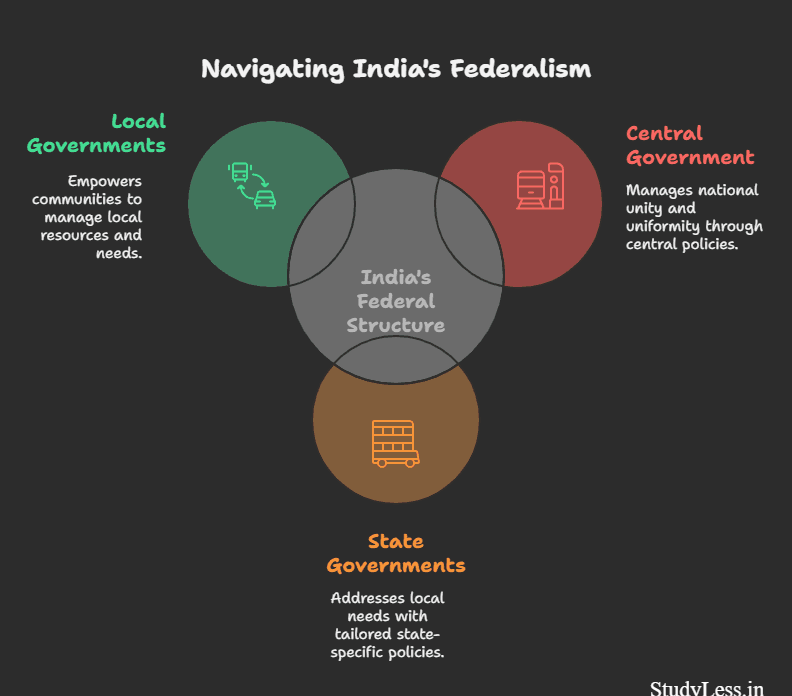
Table of Contents
🔄 Vertical Division of Power: Sharing Like Cake Layers
In modern democracies, power isn’t held by just one group. Vertical division of power means splitting authority between different levels of government. This is called federalism – a major form of power-sharing!
Example:
- Central Government (Top Layer): Manages national defense, currency.
- State Governments (Middle Layer): Handles health, agriculture.
- Local Governments (Bottom Layer): Manages your streetlights, garbage collection.
Fact: India’s federalism has three tiers – Central, State, and Local (added in the 1990s)!
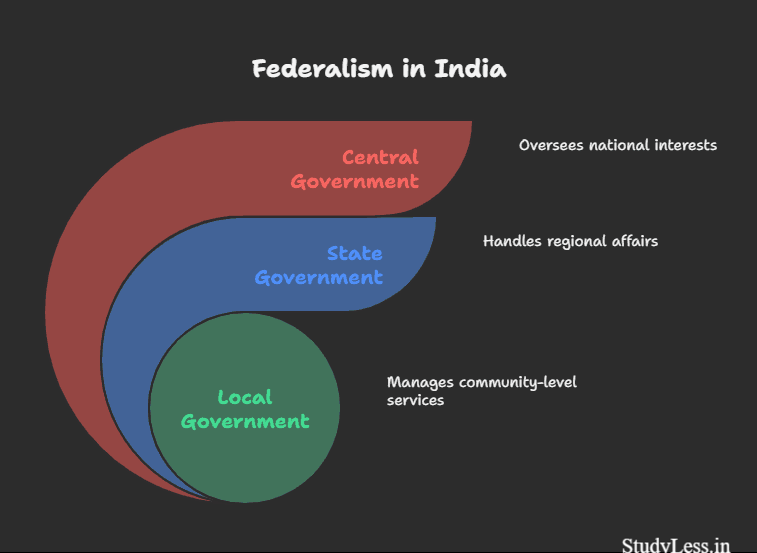
📜 Federal Constitutional Provisions: India’s Rulebook
India’s Constitution has clear rules for power-sharing:
- 7th Schedule: Divides subjects into:
- Union List (Only Central Govt): Defence, foreign affairs.
- State List (Only States): Police, agriculture.
- Concurrent List (Both): Education, forests.
- Residuary Powers: Unlisted topics (like tech laws) go to the Central Govt.
- Judiciary: Supreme Court settles disputes between governments.
Pro Tip: Remember the 7th Schedule with “Union, State, Concurrent” → U.S.C like the movie rating! 🎬
🏛️ Theory and Practice of Federalism in India
Federalism isn’t just rules – policies and politics shape it too!
- Coalition Governments (1990s): States gained power when central governments needed regional party support.
- Linguistic States (Like Tamil Nadu): Created to respect cultural identities.
Real-Life Example: During COVID, states like Kerala and Maharashtra made their own health policies, showing flexibility in federalism.
🌾 Local Government: The Third Tier of Indian Federalism
In the 1990s, India added local governments (Panchayats and Municipalities) as the third tier:
- 73rd & 74th Amendments: Made local governance mandatory.
- Reservations: 1/3rd seats for women, SC/ST communities.
Quote: “Power to the people begins at the village door.” – Inspired by Gandhiji’s Panchayati Raj vision.
❓ MCQs (Keywords Edition!)
1. Which list in the 7th Schedule includes ‘agriculture’?
a) Union List
b) State List
c) Concurrent List
d) Residuary List
Answer: b) State List
2. What strengthened federalism in India’s politics?
a) Presidential elections
b) Coalition governments
c) Military power
d) Foreign treaties
Answer: b) Coalition governments
🧠 Exam Hacks & Mnemonics
- Keyword Alert: For vertical division of power, think “Vertical = Various levels” (Central, State, Local).
- Debate Topic: “Is India’s federalism centralized or true federalism? Discuss with examples.”
🌍 Modern Democracy Connect
Global Fact: Countries like Belgium (divided into regions) use federalism to avoid conflicts. India’s three-tier system could inspire nations struggling with regional demands (e.g., Sudan).
Activity: Draw a 3-layer cake labeled Central, State, Local. Add toppings like “Defense” (Central) or “School” (Local)! 🎂
🎮 Power Sharing Explained: Belgium vs. Sri Lanka (Like a Video Game!)
Imagine two gamers: Belgium and Sri Lanka. Both start with a unitary system (one player controls everything). But Belgium later switches to multiplayer mode (federalism), while Sri Lanka stays solo. Let’s see how!
Belgium’s Power-Sharing Update (1993 Patch!)
- Before 1993: Belgium had regional governments, but the Central Government could delete their powers anytime (like a game admin).
- 1993 Change: Regional governments got permanent powers (written in the Constitution). Now, they’re like co-players – the Central Govt can’t boss them around!
- Result: Belgium became a federal system – power shared between Central + Regional Govts.
Fun Fact: Belgium has 3 regions (Flanders, Wallonia, Brussels) and 3 languages! Federalism keeps peace. 🕊️
Sri Lanka: Stuck in Unitary Mode
- Unitary System: Central Govt holds all power. Provincial Govts are like NPCs (Non-Player Characters) – they follow orders.
- Tamil Leaders’ Demand: Want Sri Lanka to switch to federalism to share power fairly.
- Conflict: Centralized power led to civil war (1983-2009). Many Tamils felt ignored.
Quote: “A tree with roots too deep can’t bend in the storm.” – Federalism helps nations adapt! 🌳
🍕 Federalism vs. Unitary: Pizza Party Analogy
- Federalism (Belgium): A pizza divided between friends. Each gets their slice (power) – no one can steal it!
- Central Govt: Manages national stuff (defense, currency).
- State/Regional Govts: Handle local issues (schools, roads).
- Unitary (Sri Lanka): One person eats the whole pizza. Others just watch.
Pro Tip: Federalism = F.E.D
- Fair power division
- Equal respect for regions
- Decentralized decisions
❓ MCQs: Test Your Skills!
1. What did Belgium’s 1993 constitutional change do?
a) Gave more power to the Central Govt
b) Made regional powers permanent
c) Banned regional governments
Answer: b) Made regional powers permanent ✅
2. Why do Tamil leaders want federalism in Sri Lanka?
a) To control the army
b) To share power with Central Govt
c) To join Belgium
Answer: b) To share power with Central Govt ✅
🧠 Exam Hacks!
- Mnemonics: U.N.I.T.A.R.Y = Unlimited National Influence, Total Authority!
- Debate Question: “Is federalism better for diverse countries? Use Belgium/Sri Lanka examples.”
🌍 Real-Life Connection
Global Issue: Countries like Syria (unitary) face civil wars due to power struggles. Federalism could help!
Activity: Role-play as Belgium and Sri Lanka leaders – argue why your system is better! 🎭
Next Up: Features of Federalism! 🚀
(Sneak Peek: Why do some federations fail? How does India’s “holding together” federalism work?)
🌟 Key Features of Federalism
1. Two or More Tiers of Government
Think of federalism like a multiplayer game with teams (government levels) working together. For example:
- Central Govt: Handles national rules (like game admins).
- State/Regional Govt: Manages local challenges (like team captains).
- Local Govt: Fixes daily issues (like players in a squad).
Fun Fact: India has 3 tiers, while the USA has 2!
2. Same Citizens, Different Jobs
All tiers govern you, but each has unique powers:
- Jurisdiction: Like school roles – Principal (central) makes rules, Teachers (state) manage classes, Prefects (local) handle lunch breaks!
- Example: Only the Central Govt can declare war, while States manage hospitals.
Pro Tip: Remember JURISDICTION = Jobs Uniquely Reserved In Specific Domains!
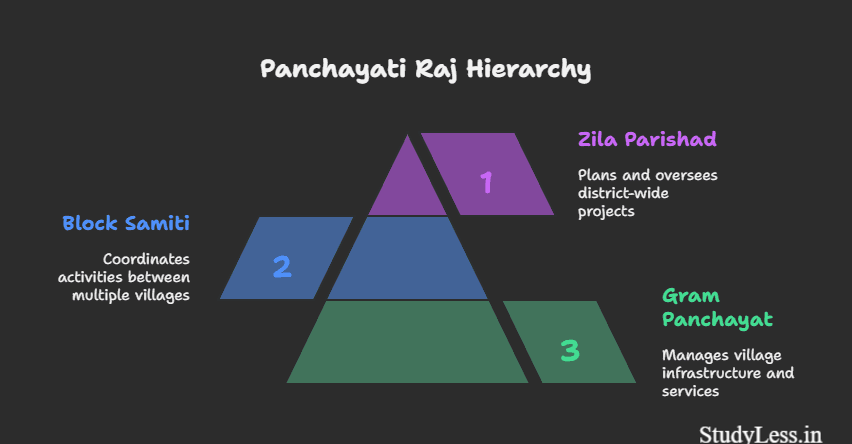
3. Constitution: The Rulebook 📜
The Constitution is the game manual that:
- Lists each tier’s powers (no overlaps!).
- Guarantees their authority – no level can delete another!
Fact: Australia’s Constitution has 128 sections – all about power-sharing!
4. No Solo Edits! Changing Rules Needs Teamwork
Imagine a group project where you can’t change the plan without everyone’s OK! Similarly:
- Constitutional changes need both central & state approval.
- Example: India’s GST tax required all states to agree! 💰
Quote: “Alone we can do so little; together we can do so much.” – Helen Keller
5. Courts: The Referees ⚖️
Courts act like game referees:
- Solve disputes (e.g., “Can the Central Govt control State forests?”).
- Protect the Constitution’s rules.
Real Case: In 2022, India’s Supreme Court settled a river water dispute between Kerala and Tamil Nadu! 🌊
6. Money Matters: Financial Autonomy
Each tier has its own income sources, like in-game currency:
- Central Govt: Income tax, customs.
- State Govt: VAT, liquor tax.
- Local Govt: Property taxes, parking fees.
Fun Fact: In Brazil, states compete to attract businesses by lowering taxes! 🏢
7. Dual Goals: Unity + Diversity = Team Spirit!
Federalism’s superpower:
- Safeguard unity (one nation).
- Respect diversity (regional cultures/languages).
Example: Switzerland has 4 languages but one national identity! 🇨🇭
❓ MCQs: Level Up Your Knowledge!
1. Who acts as the “referee” in federal disputes?
a) Prime Minister
b) Courts
c) Army
Answer: b) Courts ✅
2. Which feature stops one tier from changing rules alone?
a) Jurisdiction
b) Financial autonomy
c) Constitutional consent
Answer: c) Constitutional consent ✅
🧠 Exam Hacks
- Mnemonics: F.E.D = Finance split, Each tier independent, Dual objectives.
- Debate Question: “Can federalism work without mutual trust? Use Sri Lanka vs. Belgium examples.”
🌍 Real-Life Connection
Global Issue: Countries like Iraq struggle with centralization. Could federalism reduce conflicts?
Activity: Draw a 3-tier cake labeled Central, State, Local. Add “ingredients” like taxes, laws, and unity! 🎂
Next Up: Balance of Power – Who’s the Boss? 🤼♂️
(Sneak Peek: Why does the Central Govt sometimes override States? How do they cooperate?)
🌏 Balance of Power in Federations: Teamwork vs. Family Rules!
Let’s explore how the central vs. state power balance works in different countries – like a sports team vs. a family road trip! 🏈🚗
🏈 Route 1: ‘Coming Together’ Federations (Team Players!)
Examples: USA, Switzerland, Australia
How it works:
- Independent states (like teammates) voluntarily join to form a federation.
- Goal: Pool resources (like defense) but keep their identity (like team jerseys!).
- Power Balance: States are equally strong vs. the central government.
Fun Fact: The USA’s 13 colonies became states by choice – no king forced them! 🇺🇸
👨👩👧👦 Route 2: ‘Holding Together’ Federations (Family Rules!)
Examples: India, Belgium, Spain
How it works:
- A big country splits power to keep regions happy (like parents sharing TV time!).
- Power Balance: Central government is stronger than states.
- Special Cases: Some states get extra powers (e.g., Jammu & Kashmir pre-2019).
Quote: “Unity in diversity needs flexible rules.” – India’s federal motto!
🧩 Why Does the Balance Vary?
- History Matters!
- ‘Coming together’ federations = Fear of outsiders (e.g., USA vs. British rule).
- ‘Holding together’ federations = Fear of internal breakup (e.g., India’s linguistic diversity).
Real-Life Example:
- Australia (equal states) vs. India (strong Centre + unequal states like Nagaland).
❓ Quick Quiz!
1. Which federation type has equally powerful states?
a) Holding Together
b) Coming Together
Answer: b) Coming Together ✅
2. True or False: In ‘holding together’ federations, the central government is weak.
Answer: ❌ False! The Centre is stronger (e.g., India).
🧠 Exam Hacks!
- Mnemonics:
- C.O.M.E = Choose Outside Members Equally (Coming Together).
- H.O.L.D = Huge Original Land Divides (Holding Together).
- Debate Topic: “Should all states in a federation have equal power? Debate using USA vs. India examples.”
🌍 Next Up: What Makes India a Federal Country?
(Sneak Peek: India’s Constitution is like a rulebook for power-sharing! 📜 We’ll explore the 3 lists, the Supreme Court’s role, and how coalition governments changed the game!)
What Makes India a Federal Country? Let’s Break It Down!
🚂 India’s Federal Structure: A Train Network!
Imagine India’s government as a train system:
- Central Govt (Trains): Connects the whole country (defense, currency, foreign affairs).
- State Govts (Buses): Manage state roads (police, agriculture, local trade).
- Local Govts (Auto-rickshaws): Handle your street’s needs (water, garbage).
Fun Fact: India has 22 official languages – federalism helps respect this diversity! 🗣️
📜 The Constitution’s Rulebook: 3 Lists of Power
India’s Constitution divides power using 3 lists:
- Union List (Only Central Govt):
- Subjects: Defence, banking, foreign affairs.
- Why? We need uniform rules nationwide (like one currency!).
- State List (Only States):
- Subjects: Police, agriculture, irrigation.
- Why? States know their local needs best! 🌾
- Concurrent List (Both Central + States):
- Subjects: Education, forests, marriage laws.
- Conflict Rule: Central laws win if there’s a clash! ⚖️
Pro Tip: Remember the lists with U.S.C = Union, State, Concurrent!
🏘️ Third Tier: Power to the People!
In the 1990s, India added local governments (Panchayats/Municipalities) as the 3rd tier:
- 73rd & 74th Amendments: Reserved seats for women, SC/ST communities.
- Example: Villages now build their own wells, schools, and roads!
Quote: “The strength of India lies in its villages.” – Mahatma Gandhi
🦠 Real-Life Federalism: COVID-19 Example
- Central Govt: Set national lockdown guidelines.
- State Govts: Kerala used health workers; UP focused on migrant trains.
- Local Govts: Ensured masks and sanitizers in markets.
Fact: This shows how all tiers work together during crises!
❓ MCQs: Let’s Test Your Knowledge!
1. Which list includes “police”?
a) Union List
b) State List
c) Concurrent List
Answer: b) State List ✅
2. True or False: Local governments were part of India’s original Constitution.
Answer: ❌ False! They were added in the 1990s.
🧠 Exam Hacks!
- Mnemonics:
- Union List: Think “U for Uniform” (needs one rule for all).
- Concurrent List: “C for Common” (shared interests).
- Debate Topic: “Should education be moved to the State List? Why/Why not?”
🔍 Next Up: What About Subjects Not in Any List?
(Sneak Peek: Who controls things like cyber laws or space exploration? Hint: It’s called Residuary Powers!)
🔍 What About Subjects Not in Any of the Three Lists? The Mystery Box of Power!
Imagine you’re cleaning your room and find a box labeled “Mystery Items” – things that don’t fit anywhere else. In India’s federal system, Residuary Powers are that mystery box!
📦 Residuary Powers: Who Controls the “Mystery Box”?
The Constitution says:
- Any subject NOT in the Union, State, or Concurrent Lists goes to the Union Government (Central Govt).
- Why? To handle new, unexpected topics (like the internet in 1950!).
Examples of Residuary Subjects:
- Cyber laws (IT Act 2000)
- Space exploration (ISRO missions)
- E-commerce rules
Fun Fact: The Constitution’s Article 248 gives the Centre this power. Think of it as the “rule of the unknown”! 🕵️♂️
💡 Why Residuary Powers Matter Today
- Technology Changes Fast: The Constitution (1950) couldn’t predict TikTok or AI!
- Uniformity Needed: A national law for issues like data privacy works better than 28 state laws.
Story Time: When cybercrime spiked, the Centre made laws like IT Act 2000. States couldn’t handle it alone!
❓ MCQ Time!
1. Who holds residuary powers in India?
a) State Governments
b) Central Government
c) Local Governments
Answer: b) Central Government ✅
2. Which article deals with residuary powers?
a) Article 370
b) Article 21
c) Article 248
Answer: c) Article 248 ✅
🧠 Exam Hacks!
- Mnemonics: R.E.S.I.D.U.A.R.Y = Remember Every Strange Idea Defaults Union!
- Debate Question: “Should states have a say in residuary subjects? Discuss pros and cons.”
🌐 Real-Life Connection
Global Example: In the USA, residuary powers go to states (e.g., weed laws). India’s system is the opposite!
Activity: List 3 futuristic topics (e.g., robot rights, Mars colonies) – should they be residuary? 🤖🚀
📜 Key Quote
“A Constitution must bend with time, or it will break.” – India’s founders knew residuary powers would keep it flexible!
🌐 Union Territories: The “Younger Siblings” of Indian Federalism
Imagine a family where some kids have their own rooms (States), while others share a common space (Union Territories). Union Territories (UTs) like Chandigarh, Delhi, and Lakshadweep are areas too small to be full States but too unique to merge with others.
- Special Status: The Central Government directly controls UTs (like parents managing a shared playroom!).
- Example:
- Delhi is a UT but has some State-like powers (e.g., elected govt for education/health).
- Chandigarh serves as the capital for two States (Punjab & Haryana) but is a UT!
Fun Fact: Lakshadweep has only 1 district and 10 villages! 🏝️
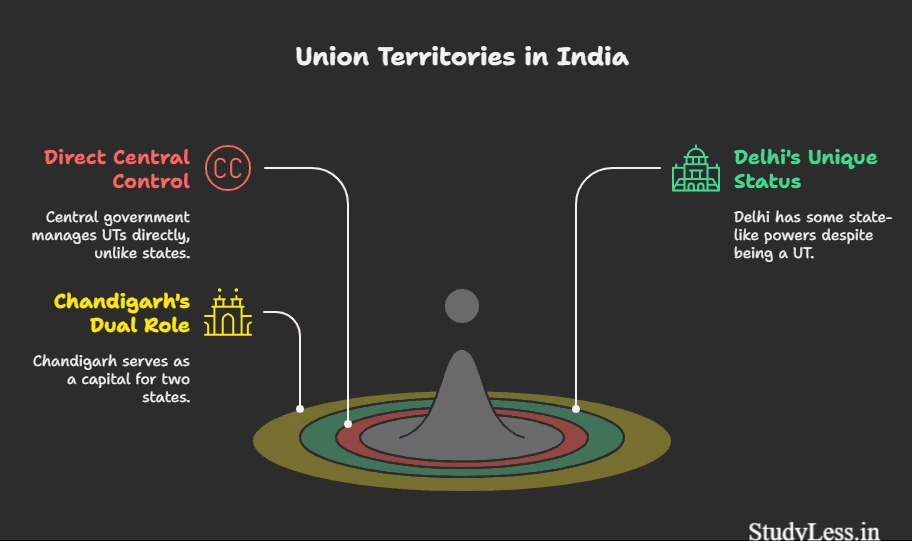
🔒 Rigid Yet Flexible: Changing the Power-Sharing Rules
India’s federal structure is like a locked treasure chest – hard to open but not impossible!
- Step 1: Parliament must pass changes with a 2/3 majority in both Houses.
- Step 2: Half the States must agree (ratify).
- Why? To protect federalism from sudden political whims!
Pro Tip: Think of it as a double-lock system – both Centre and States hold keys! 🔑
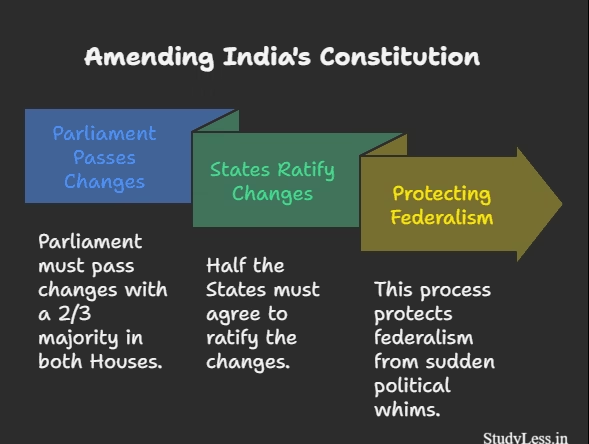
⚖️ Judges: The Referees of Federalism
Courts ensure everyone plays by the rules!
- Role of Judiciary:
- Solve disputes between Centre vs. States (e.g., Who controls water rights?).
- Supreme Court is the final umpire.
Real-Life Case: In 2020, Delhi’s Govt and Central Govt clashed over who controls administrative services. SC stepped in! 🏛️
💰 Taxation Powers: Who Collects the Cash?
Both Centre and States have their own piggy banks:
- Central Taxes: Income tax, GST (on goods moving between states).
- State Taxes: VAT on alcohol, land revenue.
Quote: “Taxes are the price we pay for civilization.” – But who sets the price? 🤔
❓ MCQs: Let’s Play Federalism Detective!
1. Which UT is the capital of two states?
a) Puducherry
b) Chandigarh
c) Lakshadweep
Answer: b) Chandigarh ✅
2. To amend the power-sharing structure, you need approval from:
a) Only Parliament
b) Parliament + Half the States
c) President
Answer: b) Parliament + Half the States ✅
🧠 Exam Hacks!
- Mnemonics:
- U.T = Unique Tiny areas.
- 2/3 + ½ = Remember the formula: Two-thirds of Parliament + Half the States.
- Debate Topic: “Should Delhi become a full State? Argue for/against.”
🌟 How is Federalism Practised?
(Sneak Peek: How does India balance unity and diversity? Think linguistic states, coalition governments, and Panchayati Raj!)
Activity: Research why Maharashtra and Gujarat were split from Bombay State in 1960! 📜
Ready for the next chapter? Let’s dive deeper into Indian federalism! 😊
P.S. Federalism isn’t just rules – it’s the art of staying united without being identical! 🇮🇳✨
🌍 How is Federalism Practised in India? Let’s Explore!
🗣️ Linguistic States: Uniting Through Language!
Imagine your classroom splitting into groups based on the languages you speak. That’s what India did! After Independence, India redrew state borders to group people by language, making governance easier and reducing conflicts.
Why Create Linguistic States?
- Example 1: Andhra Pradesh (1953) was the first state formed for Telugu speakers.
- Example 2: Gujarat and Maharashtra (1960) split from Bombay State for Gujarati and Marathi speakers.
- Not Just Language: Some states like Nagaland (Naga tribes), Jharkhand (tribal identity), and Uttarakhand (hill communities) were formed for cultural/geographic reasons.
Fun Fact: India went from 14 states in 1950 to 28 states and 8 UTs in 2024!
🧩 From Fear to Unity: The Linguistic States Story
- Early Fear: Leaders worried dividing states by language would break India apart.
- Reality: It made India stronger and more united! People felt respected, and administration became smoother.
Quote: “Diversity is our strength, not weakness.” – Inspired by Nehru
🌟 Real-Life Impact of Linguistic States
- Better Governance: Local leaders understand their people’s needs (e.g., Tamil Nadu promoting Tamil in schools).
- Cultural Pride: Kerala celebrates Onam, Punjab celebrates Baisakhi – states protect their identity.
- Reduced Conflicts: Fewer language riots after states were reorganized.
Story Time: In 1956, Mumbai almost became part of Maharashtra after protests. Finally, Gujarat and Maharashtra were split!
❓ MCQs: Test Your Understanding!
1. Which was the first linguistic state in India?
a) Tamil Nadu
b) Andhra Pradesh
c) Kerala
Answer: b) Andhra Pradesh ✅
2. Why was Uttarakhand created?
a) For Bengali speakers
b) For hill communities’ needs
c) To promote Hindi
Answer: b) For hill communities’ needs ✅
🧠 Exam Hacks!
- Mnemonics: L.I.N.G.U.A = Language Identity Nurtures Governance Unity Achieved!
- Debate Question: “Should India create more states today? Discuss using examples.”
🌐 Next Up: Language Policy – Unity in Diversity!
(Sneak Peek: How does India manage 22 official languages? Why is Hindi not the national language? Let’s decode the Three-Language Formula!)
Activity: Ask your family what language they speak at home – how would they feel if forced to use another? 💬
Ready to explore India’s Language Policy? Let’s go! 😊
P.S. India’s federalism is like a patchwork quilt – each piece unique, but stitched together with care! 🧵🇮🇳
🌐 Language Policy: India’s “Unity in Diversity” Recipe!
Imagine your school cafeteria serving dishes from 22 different cuisines – that’s India’s language policy! No single language is forced, but all are celebrated. Let’s see how!
🗣️ No National Language? Wait, What?
- Key Fact: India has NO national language! Only official languages for government work.
- Hindi: Main official language (used by ~40% of Indians).
- 22 Scheduled Languages: Like Tamil, Bengali, Gujarati, and Punjabi.
- Safeguard: Exams for Central Govt jobs can be taken in any scheduled language.
Fun Fact: India’s 22 scheduled languages are printed on currency notes! 💵
⚡ The English vs. Hindi Debate: How India Avoided a Crisis
- 1947 Plan: English would stop as official language by 1965.
- Problem: Non-Hindi states (like Tamil Nadu) protested – feared Hindi domination.
- 1965 Solution: English continued as an associate official language.
Story Time: In 1965, Tamil Nadu saw huge protests, even riots. The Centre backed down to keep peace – a masterstroke in flexibility!
Quote: “Forcing Hindi is like forcing mangoes on someone who loves apples.” – Tamil student during protests.
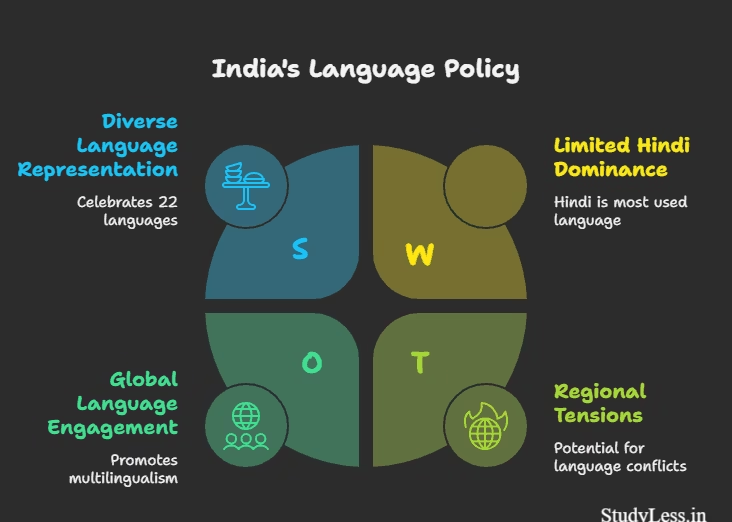
🛡️ Why India Didn’t Become Sri Lanka
- Sri Lanka: Imposed Sinhala, leading to civil war with Tamils.
- India’s Smart Move:
- No Imposition: Hindi isn’t forced on Tamil Nadu or West Bengal.
- State Freedom: Kerala uses Malayalam, Maharashtra uses Marathi for state work.
Pro Tip: The Three-Language Formula in schools:
- Regional language
- Hindi/English
- Modern Indian language
❓ MCQs: Let’s Test Your Language IQ!
1. How many scheduled languages does India recognize?
a) 15
b) 22
c) 30
Answer: b) 22 ✅
2. Why did India continue using English after 1965?
a) To please the British
b) Non-Hindi states protested
c) Hindi was too hard
Answer: b) Non-Hindi states protested ✅
🧠 Exam Hacks!
- Mnemonics: 22 Languages → 2 official (Hindi + English) + 20 others!
- Debate Topic: “Should India declare Hindi as the national language? Argue for/against.”
📱 Modern Connection: Digital India Speaks All Languages!
- UPI Payments: Use apps in Tamil, Telugu, etc.
- Aadhaar Forms: Available in 12 languages.
Activity: Check your phone’s language settings – how many Indian languages are listed? 📲
🌟 Next Up: Centre-State Relations – Teamwork Makes the Dream Work!
(Sneak Peek: How do states and Centre cooperate? What happens when they fight? Wait for the “coalition government” drama!)
Ready to decode Centre-State power games? Let’s go! 😊
P.S. India’s language policy is like a mango shake – blend many flavors, but keep it sweet and smooth! 🥤🇮🇳
🌱 Decentralization in India: Power to the People!
Imagine your school letting students manage the library, sports day, and cafeteria. That’s decentralization – handing power to local communities! In India, it means villages and towns govern themselves.
🏘️ What is Decentralization?
India’s federalism has three tiers:
- Central Government (Manages the country).
- State Governments (Manages the state).
- Local Governments (Manages your village/town).
Key Fact: Local governance was added via the 73rd & 74th Constitutional Amendments (1992).
📜 Panchayati Raj & Municipalities: Grassroots Democracy
- Rural Areas:Panchayati Raj (Village Councils) – 3 levels:
- Gram Panchayat (Village).
- Block Samiti (Block).
- Zila Parishad (District).
- Urban Areas: Municipalities (City Councils).
Reservations:
- 1/3 seats for women.
- Seats for SC/ST communities based on population.
Fun Fact: Over 14 lakh elected representatives work in local governance – the world’s largest democracy at work! 🗳️
🌟 Why Decentralize?
- Local Problems, Local Solutions: Villages know their needs best (e.g., fixing wells, building schools).
- Empower Marginalized: Women and SC/ST groups get decision-making power.
Success Story: In Kerala, Kudumbashree (women-led Panchayats) reduced poverty by starting small businesses! 💼
⚡ Challenges & Triumphs
- Hurdles: Lack of funds, corruption, and political interference.
- Progress: States like Karnataka and West Bengal allocate budgets directly to Panchayats.
Quote: “When you empower a village, you empower the nation.” – Inspired by Gandhiji’s Gram Swaraj.
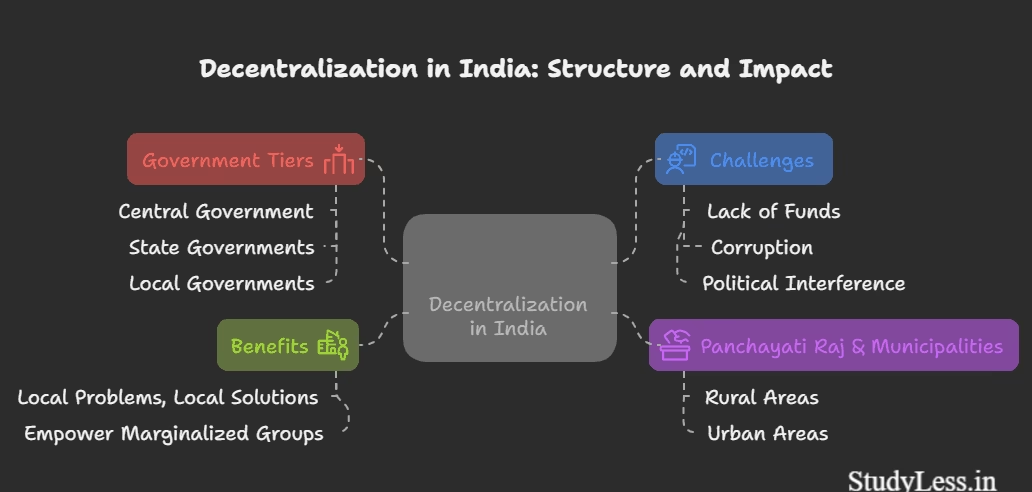
❓ MCQs: Let’s Test Your Knowledge!
1. Which amendment introduced Panchayati Raj?
a) 42nd Amendment
b) 73rd Amendment
c) 91st Amendment
Answer: b) 73rd Amendment ✅
2. What percentage of seats are reserved for women in local bodies?
a) 10%
b) 33%
c) 50%
Answer: b) 33% ✅
🧠 Exam Hacks!
- Mnemonics: 73rd = Rural (Panchayati Raj) | 74th = Urban (Municipalities).
- Debate Topic: “Should local governments get more financial power? Discuss.”
🌍 Real-Life Impact: COVID-19 & Local Governance
- Panchayats tracked migrants, set up quarantine centers.
- Municipalities organized oxygen supply and vaccines.
Activity: Interview a local council member – how do they solve issues in your area? 📞
📈 What’s Next?
(Sneak Peek: How do Panchayats fund projects? What’s the Five-Year Plan role? Let’s explore fiscal federalism!)
Ready to dive deeper? Let’s keep unraveling India’s democratic fabric! 😊
P.S. Decentralization is like planting seeds – the more you nurture local power, the stronger the nation grows! 🌱🇮🇳
🏡 Decentralization in India: Why Local Power Matters
Imagine running a school where only the principal makes every decision – from classroom timings to cafeteria menus. Chaos, right? That’s why India added local governments as the third tier of democracy! Let’s break it down.
🌍 Why Decentralize? Size Matters!
India’s states are as big as countries:
- Uttar Pradesh ≈ Russia’s population!
- Maharashtra ≈ Germany’s population!
But within these giant states, villages and towns have unique needs (e.g., water scarcity in Rajasthan vs. flood management in Assam).
Fun Fact: India has over 3 million elected local representatives – more than the population of Jamaica! 🇯🇲
🛠️ What is Decentralization?
- Definition: Shifting power from Central/State governments to local bodies (Panchayats/Municipalities).
- Why? Locals know their problems best!
- Example: A village in Kerala can build a check dam faster than a state bureaucrat in Delhi.
Quote: “The voice of the village is the voice of India.” – Inspired by Gandhiji’s Gram Swaraj.
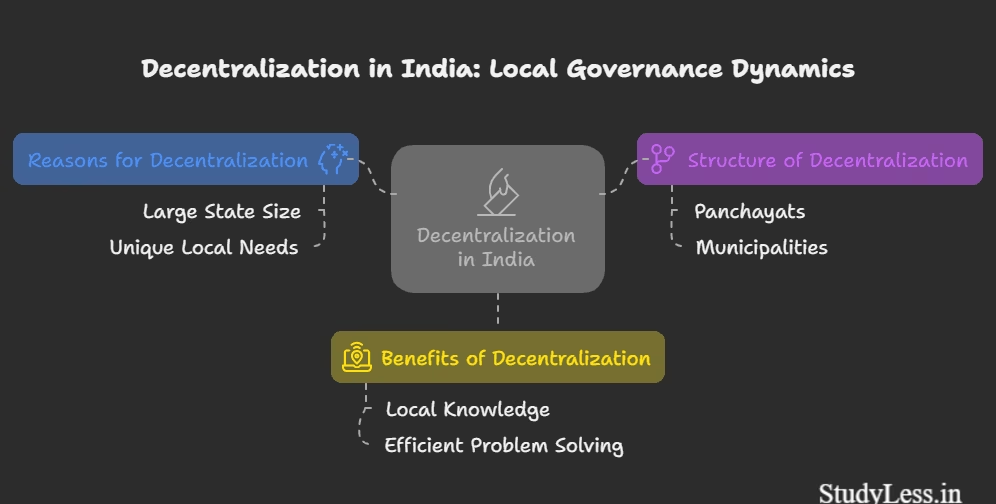
⏳ Before 1992: Weak Local Governments
- Panchayats/Municipalities existed but were puppets of State Governments.
- Problems:
- No regular elections.
- No funds or powers.
- No voice for women/SC/ST communities.
Story Time: In the 1980s, many Panchayats were dissolved by States for opposing ruling parties! 😱
✅ How Decentralization Helps Democracy
- Direct Participation: Villagers debate budgets for schools, roads, and health centers.
- Efficiency: Local leaders fix problems faster (e.g., repairing a broken well).
- Empowerment: Women and marginalized groups get decision-making power.
Real-Life Example: In Karnataka, Gram Panchayats built 2 lakh toilets in 2 years under Swachh Bharat! 🚽
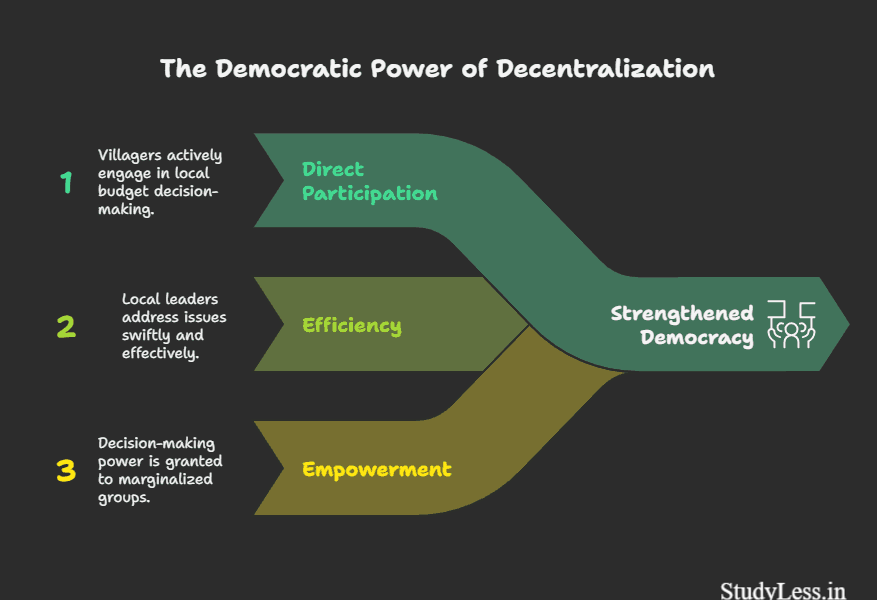
❓ MCQs: Let’s Test Your Knowledge!
1. Which tier of government is responsible for your village’s drainage system?
a) Central Government
b) State Government
c) Local Government
Answer: c) Local Government ✅
2. True or False: Before 1992, local governments had their own funds.
Answer: ❌ False! They depended on States.
🧠 Exam Hacks!
- Mnemonics: D.E.C.E.N.T = Direct Empowerment, Community Engagement, Needs Tackled!
- Debate Topic: “Is decentralization successful in India? Give examples.”
🌟 Next Up: 1992 Constitutional Amendments – The Game Changer!
(Sneak Peek: How did the 73rd & 74th Amendments transform local governance? Wait for reserved seats, elections, and financial powers!)
Ready to explore the 1992 reforms? Let’s unlock the power of villages! 😊
P.S. Decentralization is like giving everyone a remote control – locals decide their community’s channel! 📺
🏛️ The 1992 Constitutional Amendments: Empowering Local Democracy!
In 1992, India took a massive leap towards grassroots democracy! The 73rd and 74th Constitutional Amendments transformed local governments from weak bodies to powerful units. Let’s decode how!
📜 Key Changes Introduced in 1992 Constitutional Ammendment
- Mandatory Elections:
- Regular elections for Panchayats/Municipalities every 5 years. No more delays or cancellations!
- Example: Tamil Nadu held Panchayat elections in 2022 after a 6-year gap.
- Reservations for Inclusion:
- SC/ST/OBC: Seats reserved based on their population.
- Women: At least 1/3rd of all seats (many states like Bihar have 50%!).
- Fun Fact: Over 14.5 lakh women are elected representatives today – the world’s highest! 💪
- State Election Commission:
- Independent body to conduct free/fair local elections.
- Pro Tip: Think of it as an umpire ensuring no political party cheats! ⚖️
- Power & Money Sharing:
- States must share powers (e.g., water supply, roads) and revenue (taxes) with local bodies.
- Example: Kerala lets Panchayats manage 40% of the state budget! 💰
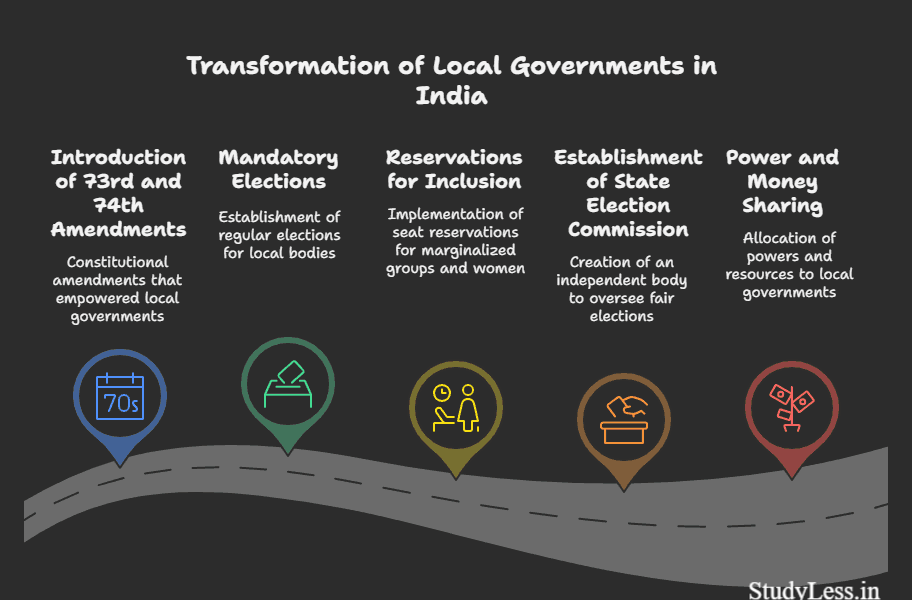
🌾 Panchayati Raj: The 3-Tier Village Democracy
Structure:
- Gram Panchayat (Village Level):
- Manages village roads, wells, schools.
- Block Samiti (Block Level):
- Coordinates between 10-20 villages (e.g., health camps).
- Zila Parishad (District Level):
- Plans district-wide projects (e.g., hospitals, colleges).
Responsibilities:
- Build toilets under Swachh Bharat.
- Run Anganwadi centers for child nutrition.
- Implement MNREGA (rural jobs scheme).
Quote: “When women lead Panchayats, villages thrive.” – Kerala’s Kudumbashree success story! 🌟
❓ MCQs: Let’s Test Your Knowledge!
1. Which amendment strengthened Panchayati Raj?
a) 42nd Amendment
b) 73rd Amendment
c) 91st Amendment
Answer: b) 73rd Amendment ✅
2. Who conducts Panchayat elections?
a) Central Election Commission
b) State Election Commission
c) Supreme Court
Answer: b) State Election Commission ✅
🧠 Exam Hacks!
- Mnemonics:
- 73rd = Rural (Panchayati Raj) | 74th = Urban (Municipalities).
- 1/3rd Women → Think “Women 1/3rd Work 1/3rd Win!”
- Debate Topic: “Should all states reserve 50% seats for women in Panchayats?”
🌍 Real-Life Impact
- Women’s Empowerment: In Rajasthan, women-led Panchayats increased school enrollment by 30%.
- Better Infrastructure: Odisha’s Panchayats built 1 lakh km of rural roads in 5 years.
Activity: Attend a Gram Sabha meeting in your village – see democracy in action! 🗣️
Next Up: Urban Local Bodies (Municipalities)!
(Sneak Peek: How do cities manage waste, water, and traffic? Let’s explore the 74th Amendment!)
Ready to dive into urban decentralization? Let’s go! 😊
P.S. The 1992 amendments turned villages from spectators to players in India’s democracy! ⚽
🌾 Rural Local Bodies: Panchayati Raj – Democracy at Your Doorstep!
Imagine your village as a mini-democracy where you elect neighbors to fix roads, build schools, and manage water. That’s Panchayati Raj! Let’s break down its structure.
🏡 Gram Panchayat: The Village Council
- Members:
- Ward Members (Panch): Elected by adults in each village area (ward).
- Sarpanch (President): Elected by the entire village.
- Role:
- Build roads, schools, and health centers.
- Manage local disputes (like water-sharing).
- Supervisor:Gram Sabha (all village voters) meets twice a year to:
- Approve the budget.
- Review the Panchayat’s work.
Fun Fact: In Kerala, Gram Sabhas decide how to spend 50% of the state’s development funds! 💰
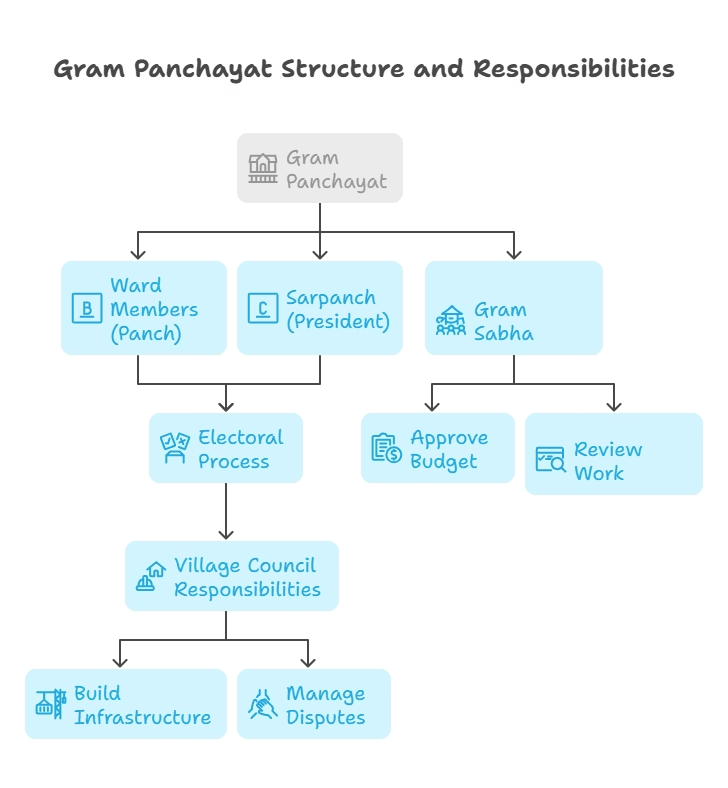
📊 Panchayat Samiti/Block/Mandal: The Middle Layer
- Formed By: Grouping 10-20 Gram Panchayats.
- Members: Elected by Gram Panchayat members + local MLAs/MPs.
- Role:
- Coordinate health camps, farmer training.
- Implement state schemes (e.g., MNREGA jobs).
Example: A Block Samiti in Rajasthan built 100 rainwater harvesting pits in drought-prone villages! 🌧️
🏛️ Zilla Parishad: The District-Level Powerhouse
- Formed By: All Block Samitis in a district.
- Members:
- Elected representatives.
- MPs, MLAs, and district officials.
- Head: Zilla Parishad Chairperson (political head).
- Role:
- Plan district-wide projects (hospitals, colleges).
- Allocate funds to Block Samitis.
Pro Tip: Think of Zilla Parishad as the “CEO” of the district! 👩💼
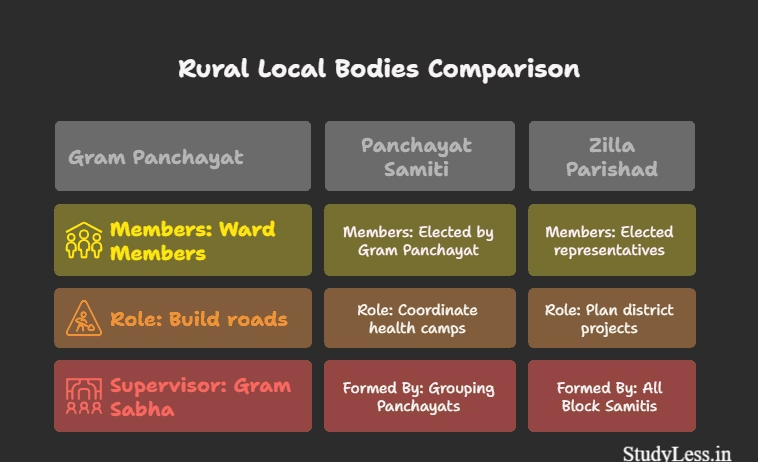
❓ MCQs: Test Your Panchayati Raj Knowledge!
1. Who elects the Sarpanch?
a) Gram Sabha
b) Ward Members
c) All village adults
Answer: c) All village adults ✅
2. What supervises the Gram Panchayat?
a) Zilla Parishad
b) Gram Sabha
c) Block Samiti
Answer: b) Gram Sabha ✅
🧠 Exam Hacks!
- Mnemonics: G.P.S.Z → Gram Panchayat → Panchayat Samiti → Zilla Parishad.
- Debate Topic: “Should MPs/MLAs have voting rights in Zilla Parishad? Discuss.”
🌟 Next Up: Urban Local Bodies – Municipalities & Corporations!
(Sneak Peek: How do cities manage traffic, waste, and water? Meet the Mayor and Municipal Commissioner!)
Activity: Attend a Gram Sabha meeting in your village – see democracy in action! 🗣️
Ready to explore city governance? Let’s head to the urban jungle! 😊
P.S. Panchayati Raj is like a banyan tree – roots (villages) strong, branches (districts) wide! 🌳
Urban Local Bodies: Keeping Cities Running!
🏙️ What Are Municipalities and Corporations?
Just like villages have Panchayats, towns and cities have municipalities and municipal corporations to manage local issues. Think of them as your city’s “captains”:
- Municipalities (Nagar Palika): For smaller towns. Headed by a Municipal Chairperson.
- Municipal Corporations (Nagar Nigam): For big cities like Mumbai or Delhi. Headed by a Mayor.
🛠️ What Do They Do?
These bodies handle daily city life:
- Basic Services: Water supply, garbage collection, street lights.
- Health & Hygiene: Building hospitals, cleaning drains, vaccination drives.
- Infrastructure: Maintaining roads, parks, and public transport (like BEST buses in Mumbai).
Example: The Bengaluru Municipal Corp installs smart traffic lights to reduce jams! 🚦
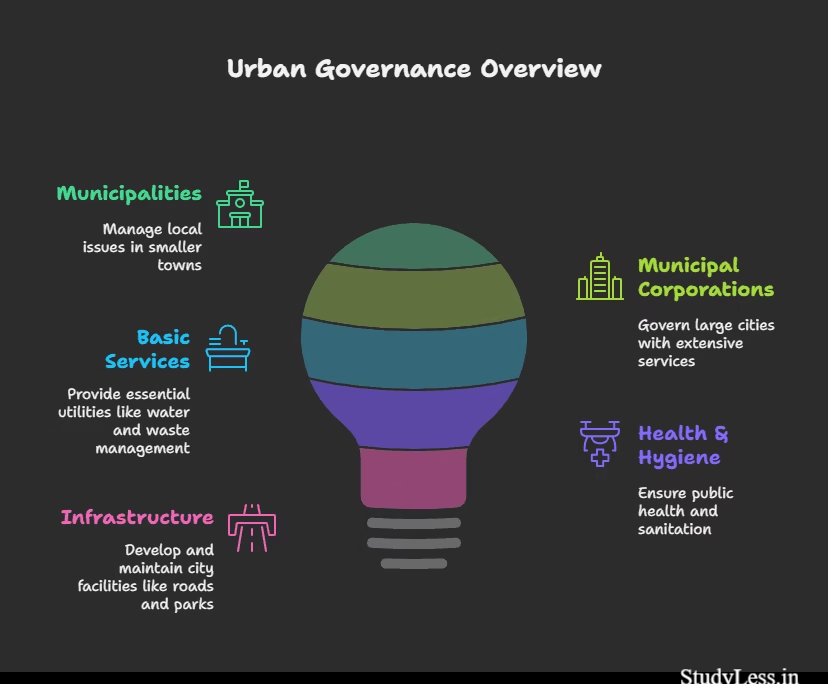
👩💼 Women Power in Local Governance
Thanks to the 1992 constitutional amendments:
- 1/3rd seats are reserved for women (some states like Bihar have 50%!).
- Over 14 lakh women lead as Mayors, Councillors, and Ward Members today!
Quote: “When women lead, cities breathe better.” – Inspired by Chennai’s former Mayor, Priya Rajan.
⚠️ Challenges: The Roadblocks
Despite progress, cities face hurdles:
- Power Shortage: States don’t share enough authority or funds.
- Gram Sabhas Missing: Unlike villages, city meetings (ward committees) are rarely held.
- Resource Crunch: Many corporations struggle with funds for projects.
Story Time: Surat became a “clean city” after its municipal corp tackled plague in the 1990s – but only after getting more powers!
❓ MCQ Time!
- Who heads a municipal corporation?
a) Sarpanch
b) Mayor
c) MLA
Answer: b) Mayor - What % of seats are reserved for women in urban local bodies?
a) 10%
b) 33%
c) 66%
Answer: b) 33%
🧠 Exam Hacks
- Mnemonics:
- Nagar Nigam = Need Now (for big cities).
- 74th Amendment = For Urban (74 has a “U” shape!).
- Debate Topic: “Should mayors have more power than MLAs in cities?”
🌆 Real-Life Connection
Activity: Spot your local councillor’s office! Notice boards in your area show ongoing projects (e.g., new park or water pipeline).
Pro Tip: Attend a ward committee meeting to see how your tax money is spent!
Conclusion: Power-Sharing & Decentralization in India – Building Democracy from the Ground Up
India’s federal structure and decentralized governance are the backbone of its democratic success, blending unity with diversity. From the vertical division of power between the Centre, States, and Local Governments to the landmark 73rd and 74th Constitutional Amendments (1992),
India’s journey highlights how power-sharing strengthens democracy.
The Panchayati Raj system (rural local governance) and Urban Local Bodies (municipalities/corporations) empower communities to address local needs—whether building schools in villages or managing waste in cities.
With 1/3rd reservations for women and marginalized groups, these institutions have transformed grassroots politics, making India home to the world’s largest cohort of elected women representatives.
However, challenges like inadequate resource sharing and irregular Gram Sabha meetings remind us that decentralization is a work in progress.
As India strives to perfect its three-tier federal model, the lessons from linguistic states, coalition politics, and local self-governance offer a roadmap for inclusive development.
Key Takeaways:
- 📜 Constitutional Flexibility: The 1992 amendments revolutionized local governance.
- 🏡 Panchayati Raj: Village councils (Gram Panchayat, Block Samiti, Zilla Parishad) drive rural development.
- 🏙️ Urban Governance: Municipalities and corporations tackle city-specific challenges.
- ⚖️ Women’s Empowerment: Reservations amplify voices in decision-making.
Quote to Ponder: “The true essence of democracy lies not just in voting, but in making every village and city a stakeholder in progress.”
Call to Action: Engage with your local governance—attend a Gram Sabha or track your city’s municipal projects. Democracy thrives when citizens participate!
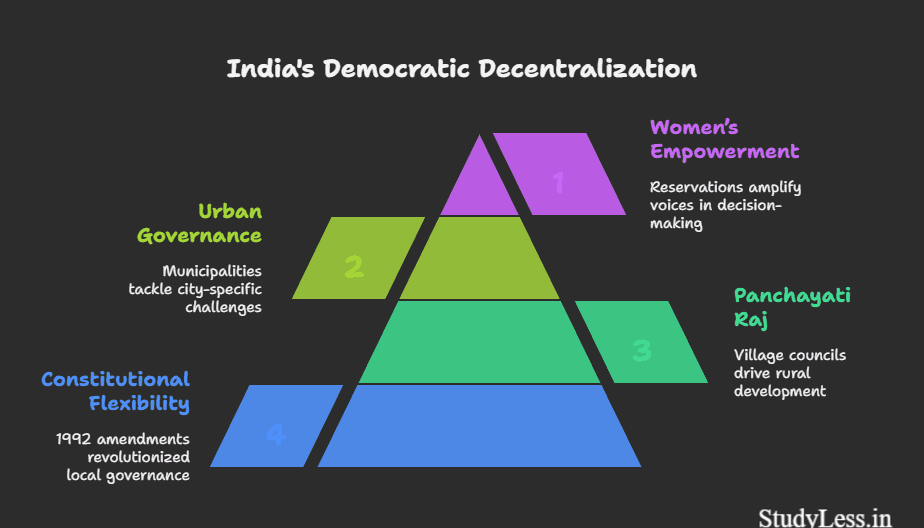
FAQs
What is federalism in simple terms for Class 10?
Federalism is a system where power is divided between a central authority (Union Government) and regional units (State Governments), ensuring shared governance.
What are the key features of federalism in India?
Key features include a three-tier system (Centre, State, Local), constitutional division of powers (Union/State/Concurrent Lists), and independent judiciary.
How is federalism practiced in India?
Through linguistic states, coalition governments, decentralization (Panchayati Raj), and constitutional safeguards for States.
What is the difference between unitary and federal systems?
In a unitary system, power rests with the Centre (e.g., Sri Lanka). In federal systems, power is shared (e.g., India, USA).
What are the Union, State, and Concurrent Lists?
Union List: Subjects like defense, foreign affairs (Centre’s control).
State List: Police, agriculture (State’s control).
Concurrent List: Education, forests (both Centre and States).
Why is the 73rd Constitutional Amendment important?
It empowered rural local governments (Panchayati Raj) with mandatory elections, reservations for women/SC/ST, and financial powers.
What is Panchayati Raj in Class 10 federalism?
A three-tier rural local governance system: Gram Panchayat (village), Block Samiti (block), and Zilla Parishad (district).
How do municipalities function in urban areas?
Municipalities (Nagar Palika) and Corporations (Nagar Nigam) manage urban issues like water supply, waste, and infrastructure.
What are the challenges of federalism in India?
Centralized decision-making, unequal resource sharing, and delays in implementing State-specific policies.
Why were linguistic states created in India?
To respect cultural diversity and ensure better governance (e.g., Andhra Pradesh for Telugu speakers).
What is the role of the judiciary in Indian federalism?
The Supreme Court resolves disputes between Centre and States, ensuring constitutional balance.
How does India’s federalism differ from the USA?
India is a “holding together” federation (strong Centre), while the USA is a “coming together” federation (equal States).
What are Union Territories in Indian federalism?
UTs like Delhi and Chandigarh are directly controlled by the Centre due to their strategic/small size.
What is the importance of the 74th Constitutional Amendment?
It strengthened urban local bodies (municipalities) with reservations, elections, and financial autonomy.
How does coalition government strengthen federalism?
Regional parties in coalitions ensure States’ voices are heard in national decisions.
What is the role of the Gram Sabha in Panchayati Raj?
Gram Sabha approves budgets, reviews Panchayat work, and ensures transparency (all village voters are members)
Why is decentralization important in federalism?
It empowers local governments to address grassroots issues (e.g., building schools, managing waste).
What are residuary powers in Indian federalism?
Subjects not in any list (e.g., cyber laws) are controlled by the Centre (Article 248).
How do States get special powers in India?
Some States like Jammu & Kashmir (pre-2019) had special status under Article 370 due to unique circumstances.
What are the advantages of federalism for Class 10?
Promotes unity in diversity, ensures regional autonomy, and encourages grassroots participation in democracy.

